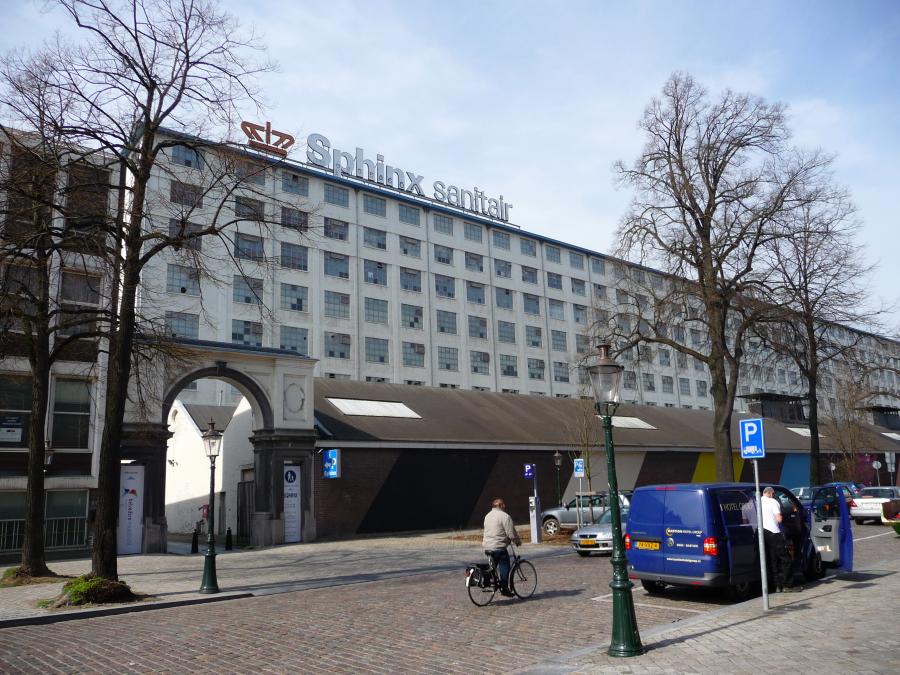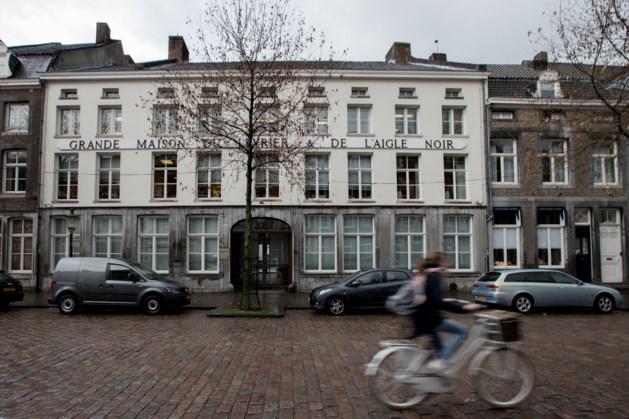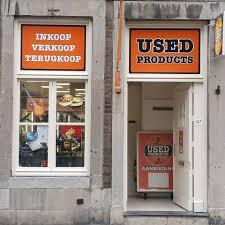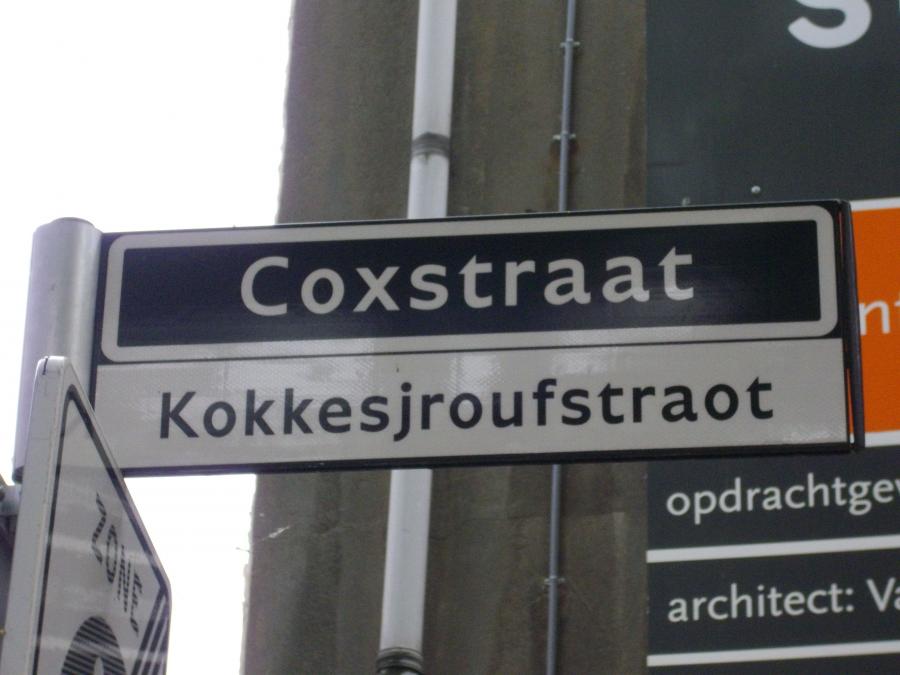
The linguistic landscape of Maastricht
A sentence written in a foreign language, a sign of an old factory that does not exist anymore, an advertisement in English - these things seem out of place. Why do we encounter such signs in public spaces all over the Netherlands? There can be many reasons: signs could reflect a historical event that took place a long time ago. They could carry traces of important figures of the past. Others might index a need to keep up with a globalizing society. All such signs are meaningful if the context is known.
In this article, we will analyze four examples from the linguistic landscape of Maastricht. Maastricht provides an advantageous scenery for linguistic landscaping as it carries traces of the past while at the same time it is also affected by globalization.
The examples we will be discussing are diverse, and they all show how something can be viewed differently by different audiences depending on the context. Our linguistic landscape examples from Maastricht show the past, present, and future of a place trying to assert its polycentric identity. The language and other semiotic resources used in the signs index this. Through our analysis, we will try to understand Maastricht's linguistic landscape better, to find out why these signs appear where they appear, what they are supposed to mean, and how they can be perceived by different (bilingual) audiences.
A factory sign in Maastricht

Sphinx Sign
Figure 1 shows a building with a sign on top that refers to the past. It is a sign indicating the late Sphinx bathroom factory. The building on which it stands now houses many smaller shops, but the sign was originally placed there by the Sphinx Company. A project developer hired by the city council to reinvigorate the area called Belvedere preserved the sign despite the factory not existing anymore. The rationale was that the district should retain its history. The future and the past now live side by side in this area, according to Maastricht's tourism website. Retaining heritage was an important consideration in the renovation project.
Further, the crown on the sign conveys a symbolic relationship with the royal house. In the past, the royal title was given to old important companies in the Netherlands. This was meant to reward them for their work for the betterment of society. The sign now simply shows that a factory was once here. It indexes that the area has a long history and heritage. This, in turn, makes it unique and historical. As we've seen, retaining this heritage was a goal of the city's development plan.
This is interesting because it shows a power shift. The function of this sign has changed over time. Originally, the sign was used to mark the factory as part of the landscape. It showed the mark that the Royal Sphinx company made in the city. The sign showed their great power in the city considering that this factory employed many of the city's inhabitants.
The factory sign shows a discontinuity in power relations and policy.
Now the city government seems to have more power over the sign. There are more small companies in that location now. However, it is the city council determines what happens with the sign above them. Since the city wants to display its heritage, the Sphinx sign remains in place. This shows how the local government now has the power to allocate and give meaning to space.
This indicates a movement from Fordist to Post-Fordist production. Post-Fordism is an economic term that refers to the era in which mass production of one good is replaced by mass production of many niched products. In the building the Sphinx sign appears on, we now find niched stores instead of one factory. At the same time, these stores are located in a building that has a distinct heritage, which is displayed by the sign as something historical. All in all, the small stores accented by heritage create a Post-Fordist scenery.
In conclusion, the Sphinx factory sign shows many things. It used to index that there was a powerful factory in this location. However, the sign's indexicality has changed. Now, this sign indexes that the government wants to accent their city with heritage, thus reinforcing Post-Fordism. In this way, the factory sign shows a discontinuity in power relations and policy. Though the sign stays the same, it is now surrounded by different contexts, gaining a multilayered meaning.
A French house name in Maastricht

French language in Maastricht
Figure 2 is a picture of a building with French text painted on its facade: "Grande Maison du Levrier et de l'Aigle Noir". This is a French name for the building, which literally translates to "the big house of the greyhound and the black eagle". This name combines the names of two establishments that were active in the building. "Hotel den Hazenwind" (Hotel the Greyhound) was the original Dutch name of a luxurious hotel that opened in the building in 1805, which was later changed into French: "Hotel du Levrier". After that establishment merged with the adjacent "Hotel l’Aigle Noir" in 1879, the names were merged into "Grand Hotel du Levrier et de l’Aigle Noir". After that, the name changed again once more, to "Grande Maison du Levrier et de l’Aigle Noir".
The building is now a government office that provides job opportunities for small entrepreneurs. So, the text on the house does not have any connection with its current function. Clearly, it served some purpose in the past. In fact, according to a government website, this building's history can be traced back to the 16th century. Even if, however, this building is no longer the famous hotel it used to be, the French text somehow remained on the house.
In order to understand why a French line appeared on a Dutch house and remained there, we need to regard it from a historical perspective. Maastricht is located in the southeast of the Netherlands. It is situated beside the walled city of Liège. Moreover, France has occupied the city several times. On June 14, 1673, the army of Louis XIV surrounded Maastricht. The French army ended up occupying the Dutch city between 1673 and 1679, after which Maastricht returned to the Dutch regime. During the French occupation, French was the language of education in Maastricht. It maintained a crucial position in both the administrative and cultural domains. As a consequence, there are still many traces of French heritage to be found, like the text on the building.
French becomes an accent in the city's identity.
We can now understand why French appears here. The reason behind this is history and in this context, a hotel named in French no longer seems so obtrusive. Besides, the connotations brought by the French language itself are very consistent with this once-popular hotel that hosted many foreign guests. Other languages cannot achieve the sense of "nobility" and "elegance" brought by French, and the previous rule of France in Maastricht brought prerequisites for this perceived linguistic superiority.
What we see in this example is something that linguistic landscape scholars have been pointing out. Namely, that space is never neutral; it is always politically, culturally, and societally embedded. The history of a public area provides a cohesive explanation for its existence.
Therefore, from the perspective of historical development, we can understand why a Dutch hotel was (re-)named in French. Today, the building no longer functions as a hotel, but the French text on it has not been removed. Its preservation is not just about its literal meaning anymore; it's now about the indexical meaning behind the text. Even though most people passing by this building may cannot understand the meaning of this text, they can probably recognize that it is French. As such, they might associate the French they see here with other French things in the city, such as French road names, French restaurants, and, most importantly, the long historical relationship between this city and France. It is this kind of recognition and association that makes this French text meaningful. It will continue to hold this meaning in the future, and it will exist in this city as a testimony that reminds people of the place's history. In this way, French becomes an accent in the city's identity.
A globalized pawnshop?

The globalized Pawnshop?
Looking at Figure 3, you will notice some texts appearing on the two upper windows. The text on the left side is in Dutch, and the other side in English. To understand why the English text appeared in a Dutch shop, we have to consider the impact of globalization in Maastricht as globalization is characterized by the mobility of people that leads to language diversity. This theory is exemplified in Maastricht. People living in Maastricht originate from a diverse range of countries. There are more than 150 nationalities represented in the city. Therefore, many languages can be found in the streets of Maastricht.
Smokotin argues that, because of globalization, the English language has established itself in the role of global lingua franca. It has thus become a symbol and a significant component of globalization. It is estimated that nearly 1.75 billion people worldwide speak English today. This grants English as a language worldwide status, making it the preferred language for international communication. As a lingua franca, English connects people, not only native English speakers, but also non-natives who speak it as a foreign language. This sign is thus used to aid communication between mobile people.
This sign indexes the city as globalized through an accent of globalization.
All in all, the indexical meaning of English text displayed on the window refers to linguistic globalization. The shop does not only use Dutch but also uses English to address a mobile audience. This helps people who cannot read Dutch to understand the referential meaning while also indexing globalization in the city of Maastricht.
Dialect and identity

Dialect and Dutch in street sign
Looking at the final image above, we see a street sign written in Limburgish, specifically the Maastricht version thereof. This is rather interesting. Almost all people who speak Limburgish speak Dutch. At the same time, there is no formal education in the dialect. So, why is it on this street sign?
To answer that question, some background knowledge on Limburgish in Maastricht is needed. Limburgish is a dialect widely spoken throughout the Dutch province of Limburg and especially Maastricht by a native population. It has been influenced by Dutch, French, and German. Furthermore, the dialect varies quite a bit depending on the part of Limburg in which it is spoken. Maastricht-based Limburgish, for instance, is more leaning towards French. It is often used by natives and the local government to distance themselves from the rest of the county. It is definitely part of Limburgish identity.
So, what could this sign mean in light of this information? The sign was placed there by the city government, which as we saw in the Sphinx example, engages in efforts to foreground a history-centred identity for the city. If dialect is part of Maastricht's identity, could they be doing the same here?
Probably. Since language and especially local language is often used as a marker of identity, it can be used to construct a certain identity for a city. This sign then indexes that the local government has the power to shape a specific identity for the city. This identity is partly based on the local dialect of Limburgish. Even though Limburgish is widely spoken by a native population who also speaks Dutch, here it is used as an accent that constructs an identity. It is made by the local government for the people and it is taken up by people who can identify the language. Those who can read it are marked as part of the same group. They are identified as part of the Limburgish-speaking community in the same way as the city is identified as a Limburgish-speaking place through this sign.
Maastricht's history through its signs
The city of Maastricht originated in the Roman Empire. Throughout history, Maastricht was occupied and governed by multiple entities, mainly of French and Dutch origin. Today, the city is situated fairly close to borders with Germany as well as Belgium. Therefore, various cultures have influenced and still influence Maastricht's identity. As a result of its geographical location, as well as its long history, Maastricht is riddled with linguistic variation. At the same time, the city is catching up with globalization and opening up gates to the English language as a global lingua franca.
The images analyzed in this article paint a picture of a place that unites three worlds: the past, the present, and the future. French influence on the city can be traced back to the Middle Ages. The hotel discussed in the second part of this paper is a brilliant example of Maastricht's complex history. Although it was originally branded with a Dutch name, it was later renamed in French. With French influence decreasing over time, and the hotel being renamed yet again, the owner could have chosen to use a Dutch designation. Yet, French was still the language of choice. Today, the name is kept as a reference to Maastricht's history and the class and grandeur that is historically connected to French, even if the building no longer houses a hotel.
The sign on the former factory of the royal Sphinx Company, on the other hand, is a marvelous example of a merger between the past and the present. The company was established in 1834, and the factory was built in the late 19th century. The factory was closed recently, ceasing production in 2009. Despite the company's disappearance, the factory marks an important milestone in Maastricht's history and thus its sign was seen as worth preserving by the local authorities.
The third sign analyzed in this paper brings together the trinity of past, present, and future. It shows that the English language has found its way into a Dutch storefront in these times of globalization. While English is not an official language in Limburg, it is spreading across the globe at an incredible pace and this includes this province. This process, which is also known as "Englishnization", is currently conquering Europe and is expected to continue doing so in the foreseeable future. In fact, corporations throughout the world are currently adopting English as their main language and are thus increasing the likeliness of further Englishnization in Maastricht or similar cities.
Maastricht balances all the influences that can be found in its linguistic landscape, which constructs its polycentric identity.
Concluding with the last image, as Dutch, French, and English seemingly dominate in the linguistic landscape of Maastricht, it does not come as a surprise that the region is keeping an old dialect alive to preserve its identity. Region-based dialects are still present in many corners around the globe, yet they are rarely as integrated as in Maastricht's linguistic landscape. In this city, residents and visitors may encounter Limburgish virtually everywhere. Maastricht balances all the influences that can be found in its linguistic landscape, which constructs its polycentric identity.
References
Chronicles of complexity: Ethnography, superdiversity, and linguistic landscapes